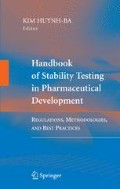Abstract
This chapter presents the global expectations of a stability program. It includes a thorough discussion of stability requirements of non-ICH regions as well as a discussion on how the climatic requirements are implied in the world. This comprehensive chapter gives an introduction of stability requirements for countries around the world. Discussions of World Health Organization (WHO) stability guidelines and Association of Southeast Asian Nations (ASEAN) stability requirements are also included.
With Contributions from: Sabine Kopp, World Health Organization, Switzerland and Saranjit Singh group, National Institute of Pharmaceutical Education and Research (NIPER), India
Access this chapter
Tax calculation will be finalised at checkout
Purchases are for personal use only
Preview
Unable to display preview. Download preview PDF.
Refernces
Schumacher P. 1972. Über eine für die Haltbarkeit von Arzneimitteln maβgebliche Klimaeinteilung. Pharm Ind 34:481–483.
Grimm W. 1986. Storage conditions for stability testing (Part 2). Drugs Made Ger 29:39–47.
Zahn M, et al. 2006. A risk-based approach to establish stability testing conditions for tropical countries. J Pharm Sci 95:946–965. Erratum 2007: J Pharm sci 96:2177
Kottek M, et al. 2006. World map of Köppen–Geiger climate classification updated. Meteorol. Z. 15:259–263
Coordinated Universal Time (UTC) follows International Atomic Time (TAI) exactly except for an integral number of seconds, presently 32. These leap seconds are inserted on the advice of the International Earth Rotation Service (IERS) to ensure that, on average over the years, the sun is overhead within 0.9 s of 12:00:00 UTC on the meridian of Greenwich. UTC is thus the modern successor of Greenwich Mean Time, GMT, which was used when the unit of time was the mean solar day.
The basic elements of the project ERA-40 are described in: Uppala S. M., et al. 2005. The ERA-40 Reanalysis. Q J R Meteorological Soc 131:2961–3012. ERA-40 is a reanalysis of meteorological observations for the period from 1957 to 2002. A summary of the project is provided in ECMWF Newsletter Nr. 101 (pages 3–22) available via http://www.ecmwf.int/publications/newsletters/
Wexler A, et al. 1971. Vapor pressure equation for water in the range 0 to 100°C. J Res Natl Bur Stand (US) – A. Physics and Chemistry 75A:213–230.
Wexler A. 1976. Vapor pressure formulation for water in the range 0 to 100°C. A revision. J Res Natl Bur Stand (US) – A. Physics and Chemistry 80A:775–785.
Hardy R. 1998. ITS-90 Formulations for vapor pressure, frostpoint temperature, dewpoint temperature, and enhancement factors. Proceedings of the Third International Symposium on Humidity & Moisture, Teddington, London, England, April
Haynes JD. 1971. Worldwide virtual temperatures for product stability testing. J Pharm Sci 60:927–929.
Who Expert Committee On Specifications For Pharmaceutical Preparations, 34th Report, Technical Report Series 863, Geneva 1996 http://whqlibdoc.who.int/trs/WHO_TRS_863_(p1-p98).pdf
World Health Organization. Expert Committee on Specifications for Pharmaceutical Preparations. 37th Report. Technical Report Series, No 908, p.13 (2003). http://whqlibdoc.who.int/trs/WHO_TRS_908.pdf
World Health Organization. 2002. “WHO Guidelines on stability testing” in: WHO Drug Information, 16(1): 35, on http://82.77.46.154/gsdldata/collect/whodruginfo/index/assoc/h2990e/h2990e.pdf#search=%22 vol%22
WHO Consultation of Stability studies in a global environment http://www.who.int/medicines/areas/quality_safety/quality_assurance/ConsultStabstudies/en/index.html
Who Expert Committee On Specifications For Pharmaceutical Preparations (October 2005) 40th Report, Technical Report Series 937, Geneva 2006, p. 12, http://www.who.int/medicines/publications/pharmprep/TRS_937.pdf
Kopp S. 2006. Stability testing of pharmaceutical products in a global environment. Regul Aff J 16(5):291–294, http://www.who.int/medicines/areas/quality_safety/quality_assurance/RAJ2006WHOStability.pdf
During the 10th summit in Vientiane, Laos, on 29 November 2004, the leaders of the ASEAN member countries agreed to accelerate the economic integration. Standards and regulations will have to be harmonised earlier than the original target in order to eliminate import duties for products, including medicinal products. For more information see the Regul Aff J (Pharma) 16:111–112 (2005).
Slamet LS, et al. 2004. Stability testing for hot and humid climates. WHO Drug Inf 18: 113–116. http://82.77.46.154/gsdldata/collect/whodruginfo/index/assoc/s14174e/s14174e.pdf#search=%22 vol%22
Resolution RE No. 398, dated 12 November 2004, published in the Official Gazette of the Union (Diário Oficial da União) on 16 November 2004, reported in Regul Aff J – Pharma, 2005, 16(2), 116
Resolution RE No. 1, dated 29 July 2005, published in the Official Gazette of the Union, Supplement to No. 146 – Section 1, Brasília – DF, on 1 August 2005.
International conference on harmonisation of technical requirements for registration of pharmaceuticals for human use – ICH harmonised tripartite guideline: “Stability testing of new drug substances and products” Q1A(R2) http://www.ich.org/LOB/media/MEDIA419.pdf
Zahn M. 1993. Stability testing in Arabic countries. Regul Aff J 4:558–561.
WHO EMRO 1994. Report on the Intercountry Workshop on the Validation of Expiry Dates of Drugs, Amman, Jordan, 29 March – 1 April 1993.
The Arab Union of the Manufacturers of Pharmaceutical and Medical Appliances (AUPAM) 1995 (updated in 2002). Arab Guidelines on Stability Testing of Pharmaceutical Products
Author information
Authors and Affiliations
Corresponding author
Editor information
Editors and Affiliations
Rights and permissions
Copyright information
© 2009 Springer Science+Business Media, LLC
About this chapter
Cite this chapter
Zahn, M. (2009). Global Stability Practices. In: Huynh-Ba, K. (eds) Handbook of Stability Testing in Pharmaceutical Development. Springer, New York, NY. https://doi.org/10.1007/978-0-387-85627-8_4
Download citation
DOI: https://doi.org/10.1007/978-0-387-85627-8_4
Publisher Name: Springer, New York, NY
Print ISBN: 978-0-387-85626-1
Online ISBN: 978-0-387-85627-8
eBook Packages: Biomedical and Life SciencesBiomedical and Life Sciences (R0)

